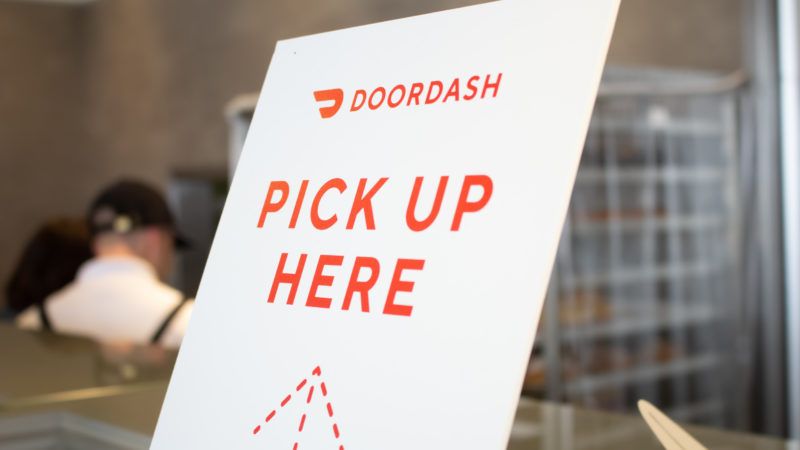Lockdown Orders Have Devastated Restaurants. Politicians Think Price Controls Might Save Them.
The Portland City Council has approved an emergency ordinance capping the fees delivery apps like DoorDash and Uber Eats can charge restaurants.

Restaurants across the country have had their dining rooms shuttered or been forced to operate under restrictive, profit-crushing social distancing protocols. City politicians are trying to throw them a lifeline in the form of price controls on delivery apps.
On Wednesday, the Portland City Council voted unanimously to cap the fees third-party delivery apps like Uber Eats and DoorDash can charge restaurants to no more than 10 percent of an order. The emergency law, which goes into effect immediately, limits these apps to a 5 percent fee for meals that are ordered through the app but delivered by restaurant employees.
It also prohibits companies from reducing delivery workers' pay to cover lost fees.
"Local restaurants are a vital community asset that provide food and jobs and contribute to the culture of Portland," said Portland City Commissioner Chloe Eudaly, who sponsored the legislation alongside Mayor Ted Wheeler, in a press release. "This ordinance protects restaurants from price-gouging during a declared emergency while protecting workers from reductions to their compensation."
Portland is hardly the first city to adopt commission caps. San Francisco, Los Angeles, Washington, D.C., and New York City have all done so as well, although these cities have limited fees to 15 percent of an order. They come at a time when restaurants are unusually dependent on delivery orders.
The counties of Multnomah, Washington, and Clackamas, which collectively cover the city of Portland, remain in phase one of the state's reopening tiers.
That means restaurants are allowed to serve customers inside but only if they are able to keep six feet of distance between tables. The maximum number of people allowed in a restaurant is either 250 or one person per 35 square feet of floor space, whichever is less. On-site food and drink service has to stop at 10 p.m.
These guidelines really restrict how many customers are able to be served. "Most floor plans pre-COVID were designed for efficiency," Nick Zukin, owner of Mi Mero Mole in downtown Portland, told Reason back in June, explaining that the phase one guidelines meant he had to downsize from 60 to 20 seats in his restaurant. (Mi Mero Mole announced in late June that it was closing for good.)
Before COVID-19 hit, there were already simmering tensions between restaurants and these apps over the fees that they charged, which could be as much as 30 percent of the cost a dish.
Katy Connors of the Portland Independent Restaurant Association (PIRA), told OPB that those fees often erased businesses profit margins, but that they were willing to accept them because delivery apps were good advertising. Someone who ordered an unprofitable delivery meal might be more willing to patronize the restaurant in person, she said.
With restaurants being forced to operate at reduced capacity, and customers less willing to eat out in public, the promotional benefit of delivery apps is essentially erased. Portland's reservations were down about 80 percent from this time last year, according to data from the restaurant reservation app OpenTable.
In response, PIRA and the Asian Pacific American Network of Oregon pushed lawmakers to adopt a cap on delivery fees.
Delivery app companies have said in written testimony to the city council that the 10 percent fee they are allowed to charge customers doesn't cover their costs and will require them to increase prices for consumers, OregonLive reports. They warn that the knock-on effect could be that fewer people will end up ordering from restaurants.
It's also hard to argue that restaurants are being gouged by delivery apps that are themselves losing money. Uber reported that Uber Eats lost over $300 million in the first quarter of 2020. Grubhub lost $33 million in the first quarter of 2020, despite seeing its revenues grow.
"Although delivery apps have proved quite popular, no one has devised a decent business model for them. At the moment, they're kept afloat thanks to lavish subsidies from investors," wrote Bloomberg's editorial board in late May. "That means consumers get deliveries for much less than they'd otherwise have to pay, and restaurants, far from being scammed, are in fact paying significantly below what the market would demand absent such support."
The fact that restaurants don't feel like they can just walk away from their relationship with delivery apps suggests that they do in fact still derive benefits from them.
That doesn't mean restaurants aren't struggling right now. The industry is in crisis, with some analysts estimating that up to 20 percent of eateries will never reopen.
But price controls are always a blunt tool. They could end up tanking delivery apps that were losing money even during much rosier economic times. A more constructive approach would be for politicians to lift lockdown orders so that restaurants can reopen the actually profitable portions of their business.
Rent Free is a weekly newsletter from Christian Britschgi on urbanism and the fight for less regulation, more housing, more property rights, and more freedom in America's cities.


Show Comments (71)